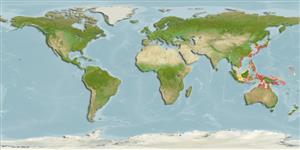>
Syngnathiformes (Pipefishes and seahorses) >
Syngnathidae (Pipefishes and seahorses) > Nerophinae
Etymology: Doryrhamphus: Greek, dory = lance + Greek, rhamphos = bill, beak (Ref. 45335).
Environment: milieu / climate zone / depth range / distribution range
Sinh thái học
Biển Cùng sống ở rạn san hô; Mức độ sâu 1 - 30 m (Ref. 90102). Temperate
Western Pacific: Japan to Indonesia. Also from Korea Rep.
Bộ gần gũi / Khối lượng (Trọng lượng) / Age
Maturity: Lm ? range ? - ? cm
Max length : 8.5 cm TL con đực/không giới tính; (Ref. 559)
Short description
Hình thái học | Sinh trắc học
Các vây lưng mềm (tổng cộng): 21-23; Tia mềm vây hậu môn: 4. Body orange yellow when fresh. Trunk rings 20, tail rings 15. Lateral trunk ridge continuous with inferior tail ridge; superior trunk and tail ridges extending forward over 4 trunk rings. Three serrated ridges dorsally on snout, the median ridge heavily serrated. Body ridges illustrating single spine except anterior six of superior trunk ridge and 3 lateral trunk ridge which has double spines. No ventrolateral projection on the snout.
Inhabits small caves in sublittoral rocky reefs. Reported from tide pools to depths of at least 25 m offshore, but mostly seen in shallow depths (Ref. 48635). An active cleaner that shares crevices with shrimps, large mud crabs and sometimes moray eels (Ref. 48635). Solitary or in pairs near sponges and Diadema sea urchins (Ref 90102). Ovoviviparous (Ref. 205). The male carries the eggs in a brood pouch which is found under the tail (Ref. 205). Spawns from the end of May to September.
Life cycle and mating behavior
Chín muồi sinh dục | Sự tái sinh sản | Đẻ trứng | Các trứng | Sự sinh sản | Ấu trùng
Monogamous mating is observed as both obligate and genetic (Ref. 52884). Male carries the eggs in a brood pouch (Ref. 205).
Masuda, H., K. Amaoka, C. Araga, T. Uyeno and T. Yoshino, 1984. The fishes of the Japanese Archipelago. Vol. 1. Tokai University Press, Tokyo, Japan. 437 p. (text). (Ref. 559)
IUCN Red List Status (Ref. 130435)
Threat to humans
Harmless
Human uses
Thêm thông tin
Các tài liệu tham khảoNuôi trồng thủy sảnTổng quan nuôi trồng thủy sảnCác giốngDi truyềnElectrophoresesDi sảnCác bệnhChế biếnNutrientsMass conversion
Các công cụ
Special reports
Download XML
Các nguồn internet
Estimates based on models
Preferred temperature (Ref.
123201): 20.7 - 29.3, mean 28.6 °C (based on 1159 cells).
Phylogenetic diversity index (Ref.
82804): PD
50 = 0.5078 [Uniqueness, from 0.5 = low to 2.0 = high].
Bayesian length-weight: a=0.00085 (0.00032 - 0.00224), b=3.04 (2.81 - 3.27), in cm total length, based on LWR estimates for this (Sub)family-body shape (Ref.
93245).
Mức dinh dưỡng (Ref.
69278): 3.7 ±0.50 se; based on food items.
Thích nghi nhanh (Ref.
120179): Chiêù cao, thời gian nhân đôi của chủng quần tối thiểu là dưới 15 tháng (Preliminary K or Fecundity.).
Fishing Vulnerability (Ref.
59153): Low vulnerability (10 of 100).
